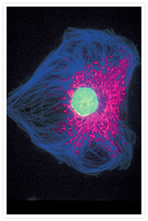Search Thermo Fisher Scientific
Endothelial cells.
Microtubules of fixed bovine pulmonary artery endothelial cells were labeled with our mouse monoclonal anti–a-tubulin antibody (Cat. No. A11126), detected with the biotin-XX–conjugated F(ab)2 fragment of goat anti–mouse IgG antibody (Cat. No. B11027) and visualized with Alexa Fluor® 488 streptavidin (Cat. No. S11223). The actin filaments were then labeled with orange-fluorescent Alexa Fluor® 568 phalloidin (Cat. No. A12380), and the cell was counterstained with blue-fluorescent Hoechst 33342 (Cat. No. H1399, H3570, H21492) to image the DNA, and red-fluorescent propidium iodide (Cat. No. P1304MP, P3566, P21493) to image the nucleolar RNA. The multiple-exposure image was acquired using bandpass filters appropriate for the Texas Red® dye, fluorescein, and DAPI.

Related Products
Related Images
A prometaphase muntjac skin fibroblast stained with Alexa Fluor® 350 phalloidin, an anti–a-tubulin antibody and an anti–cdc6 peptide antibody. Go ›

Bovine pulmonary artery endothelial cells (BPAEC). MitoTracker® Red CMXRos, SYTOX® Green nucleic acid stain, biotin-XX goat anti–mouse IgG antibody and Cascade Blue® NeutrAvidin biotin-binding protein. Go ›

Mouse Anti-Alpha Tubulin Monoclonal Antibody (Cat. No. A11126) Go ›

Muntjac fibroblast labeled with probes for actin and the nucleus. Go ›

1% Agarose gel containing 16S and 23S ribosomal RNA (rRNA). SYBR® Green II RNA gel stain. Go ›

Simultaneous detection of expression of five genes in a whole mount Drosophila embryo by fluorescence in situ hybridization (FISH) with five RNA probes Go ›
